Our vision of LOVE LEARN SHINE has learning at its heart.
LEARN
We inspire children to have a lifelong love of learning. They develop wisdom, knowledge and skills and become fluent and confident learners, who are well prepared for life in a diverse world.
Our vision translates directly into our curriculum in that;
Our curriculum promotes a love and appreciation of life and learning enabling children to SHINE, realise a passion for what is possible and enjoy life in all its fullness.
Our curriculum is aligned with the Yorkshire Causeway Trust curriculum and assessment principles. The school and trust have a vision for providing an ambitious education for all children. At St Peter’s we work closely as a school team with trust networks groups and the trust School Improvement Lead on curriculum.
YCST Teaching and Learning Principles
YCST Curriculum Design Principles
Through the work of our Trust leadership group and our subject networks groups we carefully consider how research can support the refinement of our curriculum design and implementation.
As a staff team, we work together professionally using the trust Teaching and Learning Principles and the associated key models and principles to help us realise our vision for learning. Below are examples of some of the key principles and models we are applying and using in school.
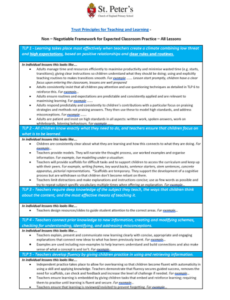
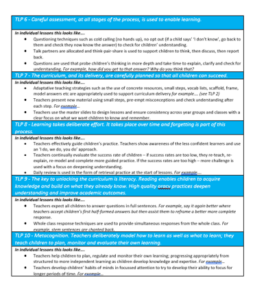
Our ‘Framework for Expected Classroom Practice’, based on the trust Teaching and Learning Principles, supports the achievement of consistent high quality approaches to learning across classes.
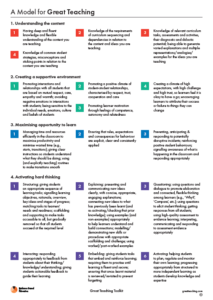
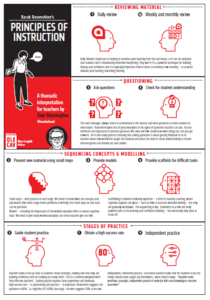
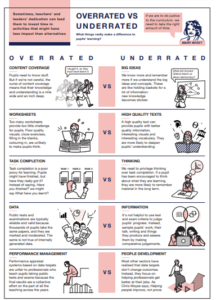
Key principles and models we are applying and using in school:
Mary Myatt What Makes a Difference to Children’s Learning?
| Intent – What and When
Curriculum intent refers to what children are taught, when and why. Our curriculum is being developed to ensure our children learn knowledge and concepts for all subjects in depth. We achieve this through carefully planned sequences that are effectively ordered so that children build knowledge sequentially. Our curriculum has been carefully designed to ensure the precise knowledge children are expected to learn is explicit. Our curriculum map and sequences have considered that our curriculum is delivered within mixed age classes.
|

Curriculum Overview Map 2023 to 2024 Block Teaching Overview 2024 – 2025
|
“A collection of learning materials is no more a curriculum than a pile of bricks is a house. What students need are carefully organised, sequential, structured introductions to school subjects”
‘Long term memory is integral to all our mental processes. When we try to solve any problem, we draw on all the knowledge that we have committed to long term memory. We cannot outsource memory to Google.’
‘Knowledge makes you a better reader, but it is also necessary to be a good thinker.’
‘A teacher’s job is not to make work easy. It is to make it difficult. If you are not challenged, you do not make mistakes, if you do not make mistakes then feedback is useless.’
John Hattie
Implementing Our Knowledge Rich Curriculum
Quality first curriculum implementation enables children to progress* well, knowing and remembering more.
*Progress is the alteration of long-term memory.
Carefully planned sequences are mapped out over each phase and are outlined in our Curriculum Overview Map for each subject. These play a key role in quality first curriculum implementation.
In addition, a clear and sharp focus on the core knowledge for each sequence plays an important part in helping children know and remember more.
Teaching emphasises the importance of knowing and understanding the key vocabulary associated with subject. We have developed a classroom culture of remembering, where children understand the methods adults use to help them remember more. For example, frequent deliberate practice and low stakes recall quizzes are used to support children to retrieve knowledge.
As a staff team, St Peter’s have developed a curriculum that is not only well-planned, systematic and knowledge-rich but also ensures children know how their teachers’ methods are helping them to remember knowledge and develop fluency. To create a strong classroom culture of remembering, we have worked together to develop a whole school approach that is consistently applied using the Trust Teaching and Learning Principles.

We have changed from the previous curriculum culture “I can do by the end of lesson” to “I am practising …… so I will remember …….”
|
Our Brains
The brain naturally forgets knowledge it takes in the first time. It remembers new knowledge for longer when it is revisited again and again over a few days or weeks.
The more brains remember the knowledge the longer it stays in memory. This is called retrieval and is why using flashcards is so useful. |
Types of Memory
There are two types of memory:
• Short term ‘working’ memory • Long term memory
Short memory is used to think. Attention must be given to the knowledge for it to enter short-term memory. Thinking about knowledge, through answering questions, allows it to transfer to long term memory. |
Tips for Remembering More
Learning takes time and effort.
Regularly revisiting and recapping knowledge and vocabulary is essential in order for it to be learned and retained.
Regular use and application of knowledge and vocabulary also support retention. |

|
 |
 |
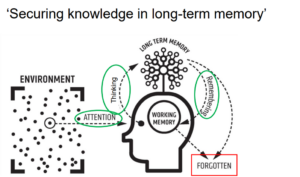
Classroom Strategies that Promote a Culture of Remembering
Impact is what children achieve as a result of the curriculum they have been taught and learnt.
Our fidelity to systematic approaches in teaching fundamental basics, such as: phonics, additive facts and multiplication tables impact on children’s fluency and confidence. Children build knowledge and skills quickly, so they are ready to progress and are able to access age-appropriate content throughout their primary years. They are also well-equipped to think more deeply and apply these skills to a range of different problem-solving contexts.
Our carefully considered sequentially organised subject based curriculum, allows children to build knowledge over time in all National Curriculum subjects as well as the subjects beyond the National curriculum such as RE and PSHE. The confidence they have from the security of their knowledge prepares children well for further study of these subjects in Key Stage Three and beyond.
The sharp focus on reading well and promoting a love of reading impacts positively on our children academically and emotionally. They become lifelong readers who understand that reading enables them to access learning across the curriculum and also contributes to good emotional wellbeing.
The focus within our curriculum of designing learning that challenges children to think deeply means children retain knowledge well for the future, which prepares them for their further studies. It also as develops their ability and capacity to think critically and evaluate effectively, which are both essential life skills that can be applied widely within and beyond educational settings.
The curriculum builds resilience through deep thinking, which impacts positively on children’s willingness to persevere and work with others. They develop interest and enthusiasm for learning as well as the ability to reflect, consider other perspectives and develop empathy and understanding.
There is further information regarding the impact of our curriculum on each individual curriculum page.
